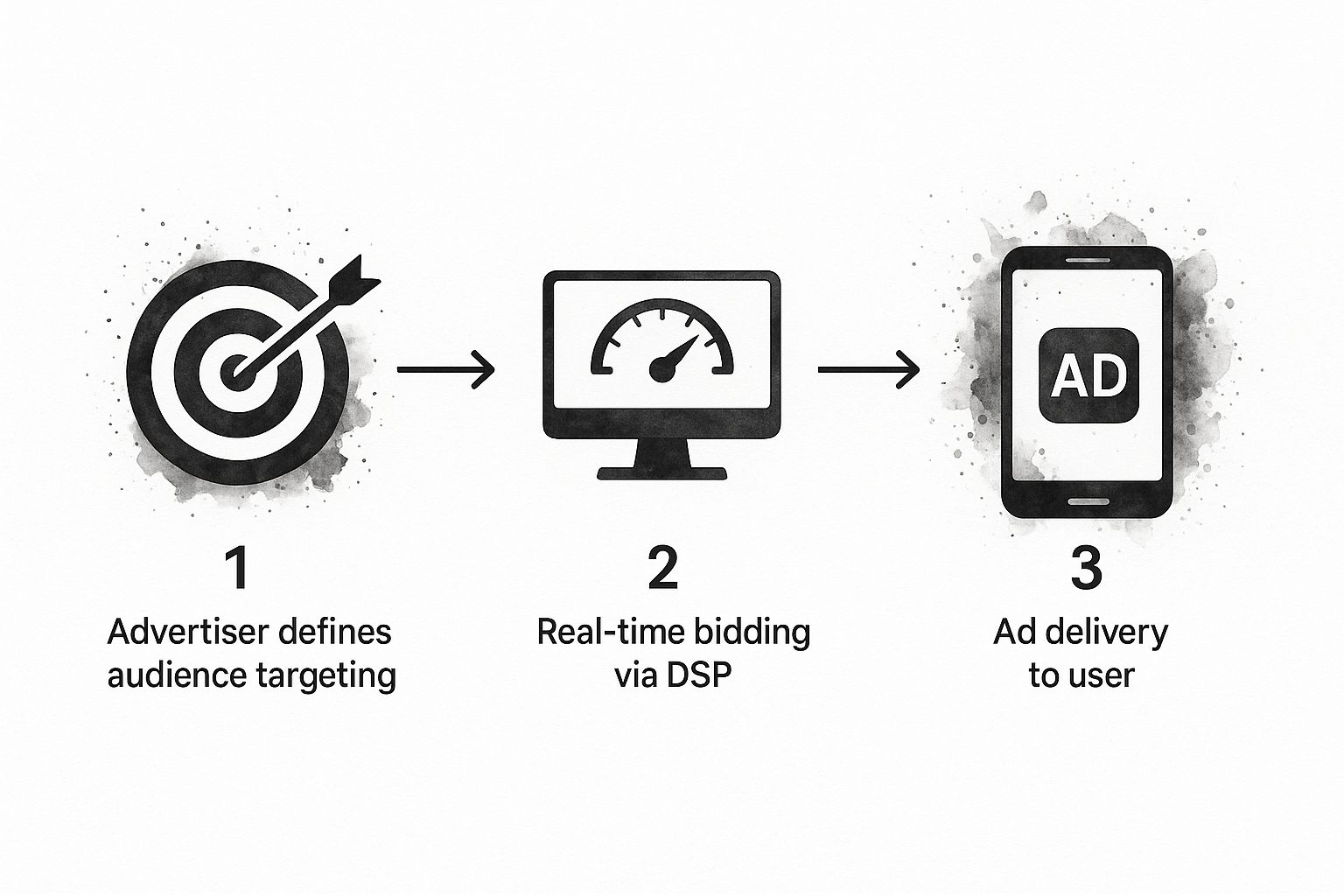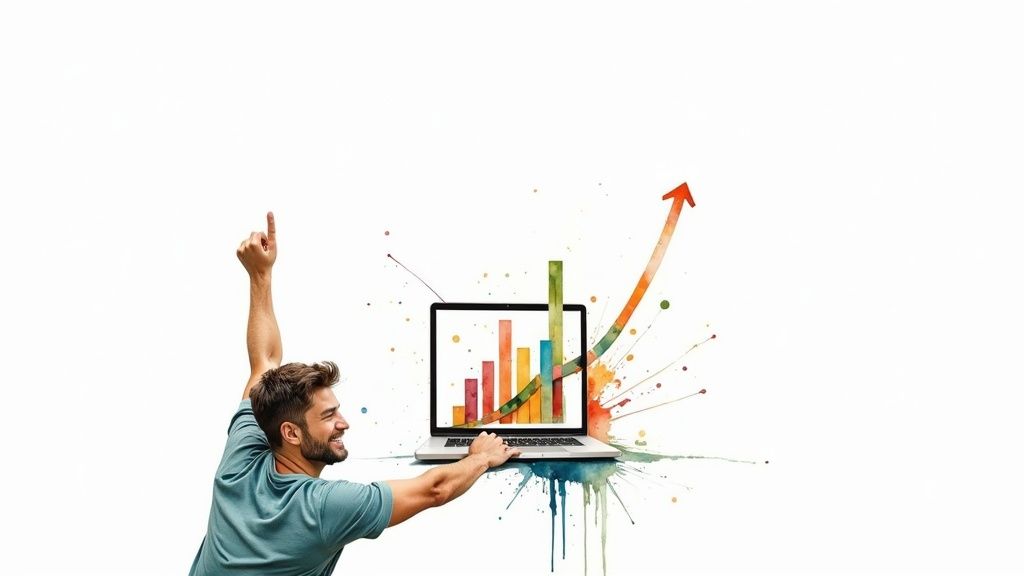Ever wonder how an ad for a product you just viewed follows you across the internet? That’s not magic; it’s a high-speed, automated stock market for digital ad space. That’s the simplest way to answer the question, what is programmatic display advertising? It's a technology-driven method that automates buying and selling digital ads in the time it takes a webpage to load, ensuring your message reaches the right person, at the right time.
So, What Is Programmatic Display Advertising, Really?

At its heart, programmatic display advertising is a massive leap forward from the old-school way of buying ads. Gone are the days of endless phone calls and manual negotiations to place an ad on a single website. Instead, intelligent algorithms handle the entire process in real-time, matching your ad with the perfect user at the most opportune moment.
For a local business, this changes everything.
Let's imagine a realtor in Boca Raton. In the past, they might have bought a banner ad on a local news site and just hoped the right people would see it. With programmatic, they can show their ad specifically to users who have recently searched "homes for sale in Boca Raton" or browsed mortgage calculator websites. The ad follows the person, not just the website.
This entire process eliminates guesswork and manual labor, creating a more efficient, results-oriented way to advertise. It all hinges on a network of platforms that work together seamlessly in milliseconds.
In short, programmatic advertising is all about precision and automation. It lets businesses stop buying broad, generic ad space and start buying direct access to specific, high-intent audiences, no matter where they happen to be online.
To really grasp this, you need to know the key players that make these split-second auctions happen. Each component has a critical job in connecting your ad with a potential customer. You can learn more about this and other powerful strategies on our digital advertising blog.
Key Players in the Programmatic Ecosystem
To make sense of how this all works, it helps to know who's who in the programmatic world. These are the core components that form the backbone of the automated ad-buying process.
The table below breaks down the main players and their roles. Think of it as your cheat sheet for understanding the programmatic landscape.
| Component | What It Stands For | Its Role in the Process |
|---|---|---|
| Advertiser | N/A | The business or brand (that's you!) that wants to run ads to reach new customers. |
| Publisher | N/A | The website, app, or blog owner who has ad space available to sell. |
| DSP | Demand-Side Platform | The software advertisers use to manage their ad buys across many publishers from one central dashboard. |
| SSP | Supply-Side Platform | The software publishers use to manage and sell their ad inventory to advertisers. |
| Ad Exchange | N/A | The digital marketplace that connects DSPs and SSPs, allowing them to buy and sell ad inventory through real-time auctions. |
Understanding these roles is the first step. Advertisers use DSPs to set their campaign goals, while publishers use SSPs to make their ad space available. The Ad Exchange is the trading floor where it all comes together in an instant.
With this foundation, we can now dig into exactly how that lightning-fast ad auction works.
How the Programmatic Ad Auction Actually Works
To really wrap your head around programmatic advertising, you have to appreciate the sheer speed of it all. Let’s follow a single ad's journey.
Picture this: a potential homebuyer in your city is scrolling through a real estate blog. The instant they click on an article, a high-stakes auction kicks off and concludes in less time than it takes to blink. This isn't science fiction; it’s happening billions of times every single day.
The engine driving this whole operation is a technology called Real-Time Bidding (RTB). Think of it as the marketplace where your ad competes against others for that specific person's attention—all in about a tenth of a second.
The Split-Second Transaction
Let's break down that journey step-by-step, sticking with our real estate example.
-
The User Arrives: Our homebuyer lands on a blog post titled "First-Time Homeowner Tips." As the page loads, the publisher’s website uses its Supply-Side Platform (SSP) to send out a flare. It's essentially shouting, "I've got an open ad spot and a user with these specific traits looking at it right now!"
-
The Bidding Begins: That signal instantly hits an Ad Exchange, which is like a massive digital stock market for ads. The exchange blasts the opportunity out to countless Demand-Side Platforms (DSPs). Your DSP, where you’ve set up your campaign, spots the signal. It immediately recognizes the user—they’ve searched for local homes, looked at mortgage calculators, and match your target demographic. It’s a perfect fit.
-
The Auction is Won: Based on the budget and rules you defined, your DSP places a bid on your behalf. Other advertisers are doing the exact same thing. The Ad Exchange hosts a lightning-fast auction, and the highest bidder wins the spot.
-
The Ad is Served: The winning ad—yours!—is instantly beamed back to the blog and pops up right in front of the homebuyer. This entire cycle, from request to display, is over before the page has even finished loading.
This visual helps simplify that complex journey, showing how advertisers target their audience, participate in the real-time bid, and get the final ad onto the user's screen.

This entire flow is designed for one thing: precision. You're not just buying space on a website; you're buying access to a specific individual.
The Unseen Power of Data
So, what makes this instant auction so smart? In a word: data.
The unsung hero here is the Data Management Platform (DMP). It’s a powerful tool that collects, sorts, and makes sense of huge volumes of anonymous user data, organizing it into neat audience segments.
When your DSP sees an ad opportunity, it checks in with the DMP to confirm the user truly matches your ideal customer profile. This is the final check that ensures you're only bidding on the most valuable eyeballs.
This level of detail and speed is completely changing how brands spend their money. The global programmatic display market is on track to hit $85.4 billion in 2025 and is projected to grow at an incredible 24.6% each year through 2035.
That explosive growth is all thanks to big data and AI, which give advertisers the ability to read consumer signals and adjust campaigns on the fly. You can dive deeper into these trends in the full report from Future Market Insights. At the end of the day, this isn't just about automation. It's about making intelligent, data-backed decisions that squeeze the most value out of every single dollar you spend.
The Real-World Benefits For Your Business

It’s one thing to understand the tech, but the real question is always: what’s in it for my business? The true value of programmatic advertising isn’t just in its fancy features, but in how those features translate into real, bottom-line advantages that grow your company.
Instead of the old "spray and pray" method of buying ad space, programmatic lets you connect with your ideal customers with almost scary accuracy. That’s the game-changer. It’s a fundamental shift from shouting at a crowd to having a meaningful conversation with the right person.
The core benefit here isn’t just automation; it's intelligence at scale. Programmatic gives small and local businesses the power to reach the same high-value audiences that, until recently, only the big-budget national brands could afford to target.
This isn't a niche trend; it's the new standard for digital advertising. Global programmatic ad spend is expected to leap from $678.37 billion in 2023 to a massive $802.34 billion in 2024. That kind of explosive growth happens for one reason: it delivers superior, data-driven results that you can see.
Let's break down the three biggest benefits you'll experience firsthand.
Unmatched Targeting Precision
This is, without a doubt, the single biggest advantage. Programmatic targeting goes so much deeper than just age and location. It lets you find customers based on what they’re doing right now—their real-time behaviors, their interests, and what they intend to buy next.
Think about it:
- Geofencing: A local car dealership can show ads to people who have physically visited a competitor's lot in the last 24 hours.
- Behavioral Targeting: A home remodeling company can target users who have recently been searching for "kitchen renovation ideas" or watching DIY videos about bathroom makeovers.
- Retargeting: An e-commerce boutique can remind shoppers about the exact pair of shoes they left in their cart, nudging them to complete the purchase.
This level of precision means your ad budget is spent talking to people who are actually in the market for what you sell, slashing wasted spend.
Smarter Budget Optimization
With traditional advertising, you often get locked into a fixed price, whether the ad works or not. Programmatic completely flips that script with real-time bidding (RTB).
This makes every dollar in your budget work harder. Instead of a flat rate, you bid on individual ad impressions in real-time. The system is smart, automatically prioritizing the ad placements and audiences that deliver the best Return on Investment (ROI). If one group of customers is converting like crazy, the system shifts more budget there on the fly. It's this exact principle that powers our Adfuel Plus program, maximizing lead generation for our clients.
Time-Saving Automation
Finally, think of all the hours spent haggling with individual website owners or juggling different ad buys. Programmatic automation takes all of that off your plate.
It frees up you and your team to focus on what actually moves the needle: crafting a winning strategy, designing compelling ads, and actually growing your business. All the campaign management—from the bidding to the reporting—is handled cleanly through one platform. You get a single, clear view of everything that's happening, without the headache.
Programmatic vs Traditional Ad Buying

To really get what makes programmatic advertising so different, you have to look at how things used to be done. The old, manual way of buying ads feels worlds apart from today’s automated systems.
Think of it like this: traditional ad buying was like calling a stockbroker for every single trade. It worked, but it was slow and clunky. Programmatic is the high-frequency trading floor of advertising—operating with a level of speed, intelligence, and efficiency that was once unimaginable.
In the old days, buying ad space was all about relationships and manual negotiations. If a local real estate agent wanted to run an ad on a popular city news blog, they’d have to track down a sales rep, haggle over a fixed price for a specific spot, and sign a bunch of paperwork.
The whole process was slow, often pricey, and incredibly imprecise. That ad would show up for every single person who visited the page, whether they were looking to buy a house or just checking the weekend forecast. It was a spray-and-pray approach that burned through ad budgets.
The Fundamental Shift in Strategy
Programmatic advertising completely flips that model upside down. Instead of buying a block of ad space on one website, you're buying access to individual users, one impression at a time, across a massive network of sites. It's a seismic shift from targeting websites to targeting people.
This automated approach unlocks two game-changing advantages:
- Auction-Based Pricing: Forget fixed rates. You enter a real-time auction where your budget is used to bid on impressions matching your exact criteria. This ensures you never overpay for a placement.
- Audience-Centric Targeting: The focus is no longer on the publisher—it's on the person. You can pinpoint users based on their recent online behavior, demographics, and what they’re interested in right now, reaching them wherever they are on the web.
The old way was like renting a billboard on a busy highway and just hoping the right cars drive by. The programmatic way is like having a personal valet who shows your ad only to the drivers who have been test-driving similar cars all week.
This contrast makes it crystal clear why programmatic has become the engine of modern digital advertising. To see how this powerful approach can work for your business, you can schedule a free strategy session with our team.
Programmatic vs. Traditional Ad Buying at a Glance
To put it all in perspective, the table below offers a direct, side-by-side comparison. It highlights the key differences that have the biggest impact on your budget and your results. This head-to-head view makes it obvious why understanding programmatic is so crucial for any modern business.
| Feature | Programmatic Advertising | Traditional Ad Buying |
|---|---|---|
| Buying Process | Automated, real-time auctions via software platforms. | Manual negotiations, phone calls, and contracts with publishers. |
| Speed | Milliseconds to buy and serve an ad. | Days or weeks to launch a campaign. |
| Targeting | Hyper-specific user-level targeting (behaviors, intent, demographics). | Broad audience targeting based on the website's general readership. |
| Pricing | Flexible, auction-based (CPM), optimized for performance. | Fixed, pre-negotiated rates, regardless of performance. |
| Scale & Reach | Access to millions of websites through various ad exchanges. | Limited to the specific websites you negotiate with. |
| Optimization | Campaigns are optimized in real-time based on live data. | Adjustments are slow and require new negotiations. |
The differences are stark. Programmatic advertising gives you the speed, precision, and flexibility needed to get the most out of every dollar you spend.
Common Questions About Programmatic Advertising
Even after breaking down the benefits and strategies, you probably still have a few questions floating around. That’s completely normal. This technology is incredibly powerful, but it can feel a little complex at first.
Let's clear the air. We've put together answers to the most common questions we hear from business owners about programmatic advertising. Our goal is to iron out any lingering doubts and show you just how attainable this approach really is.
How Much Does Programmatic Advertising Cost?
This is always the first question, and the answer is one of programmatic’s greatest strengths: it's completely flexible. Forget the old way of buying ads with fixed, non-negotiable prices. Programmatic works like a real-time auction, and you're always in the driver's seat.
You decide on a budget you're comfortable with, whether that's a few hundred dollars for a tight, local campaign or a larger investment to reach a wider audience. The system then goes to work, finding the most effective ad spots that fit within your spend. There's no one-size-fits-all price tag, which makes it a scalable and accessible option for businesses of any size.
Is Programmatic Advertising Only for Big Companies?
Not a chance. This is one of the biggest myths out there. While huge corporations certainly rely on it, programmatic advertising is a game-changer for small and medium-sized businesses. It gives a local real estate agent, a neighborhood cafe, or an independent contractor access to the same sophisticated targeting tools once reserved for Fortune 500 companies.
Because you can run campaigns laser-focused on specific zip codes or incredibly niche audiences, you can compete effectively without needing a massive budget.
Programmatic advertising isn’t about the size of your company; it’s about the precision of your targeting. It allows smaller players to outsmart, not outspend, their larger competitors by focusing on quality over quantity.
How Is This Different from Google Display Ads?
This is a great question. It’s helpful to think of the Google Display Network (GDN) as one big, important neighborhood in the sprawling city that is programmatic advertising. When you run ads directly through Google, you get access to their massive inventory of sites and apps, which is fantastic.
But a true programmatic strategy, powered by a Demand-Side Platform (DSP), takes you a step further. It gives you access to the GDN plus a whole universe of other ad exchanges, networks, and publishers all at once. This dramatically expands your reach, helping you uncover valuable audiences and ad placements that simply aren't available through Google alone.
How Do I Know If My Campaign Is Working?
Success is always measured against the goals you set from the start. Before launching any campaign, you need to define your Key Performance Indicators (KPIs).
- For Lead Generation: Your focus will be on your Conversion Rate (the percentage of people who take the action you want) and your Cost Per Acquisition (CPA).
- For Brand Awareness: You’ll likely pay more attention to Reach (how many unique people saw your ad) and Viewability (whether the ad was actually in a viewable spot on the screen).
Other vital signs like Click-Through Rate (CTR) and—most importantly—your Return on Ad Spend (ROAS) give you the full story. Modern programmatic platforms provide detailed, real-time dashboards that make it simple to watch these KPIs and prove your investment is delivering.
Ready to see how programmatic advertising can fill your sales pipeline with qualified leads? The team at Digital Advertising Direct builds and manages high-performance campaigns that deliver real results. Get a free strategy session today and discover how we can help your business grow.


